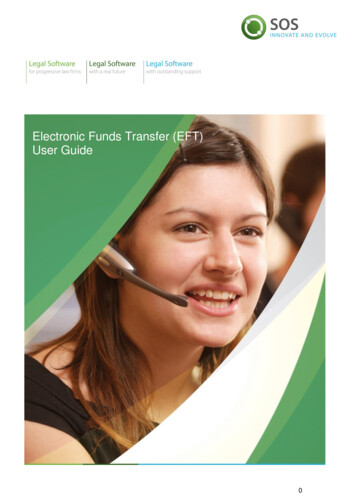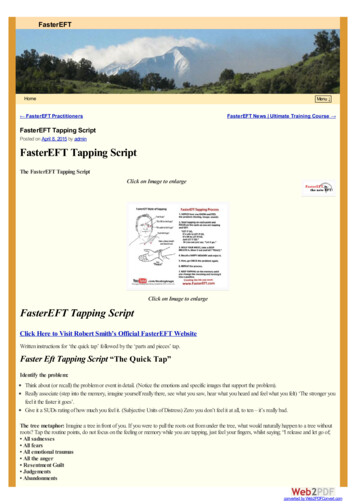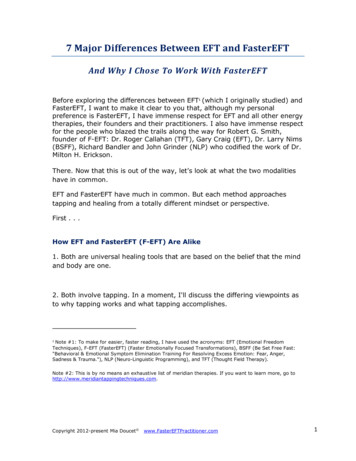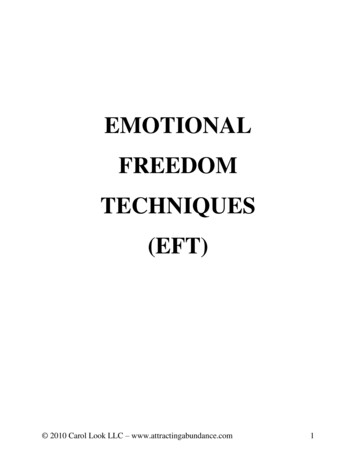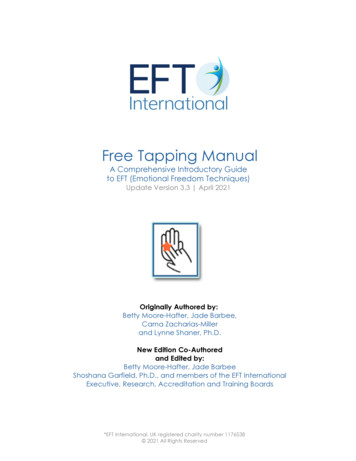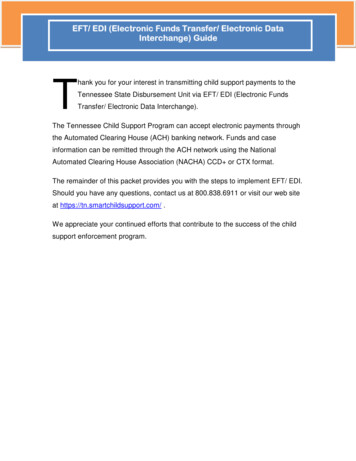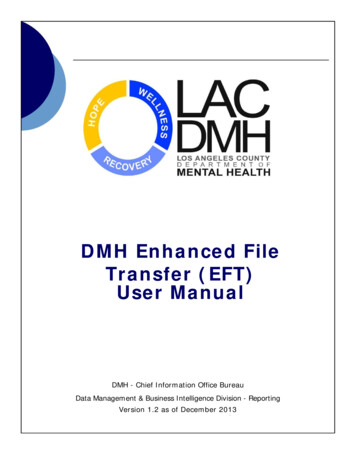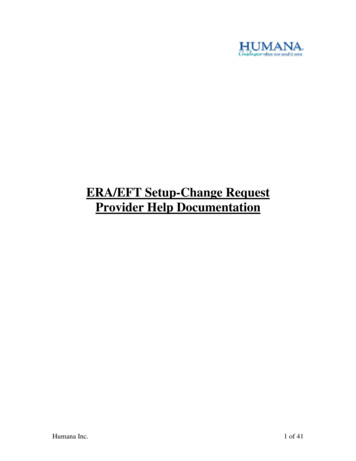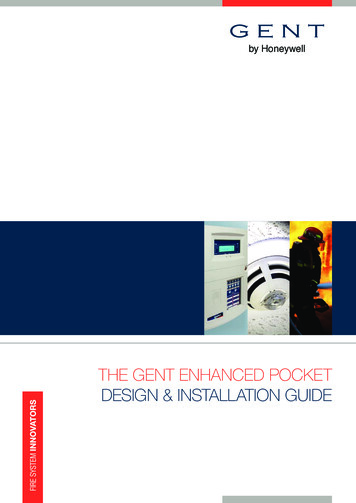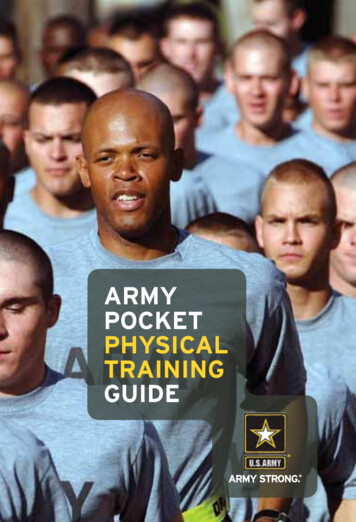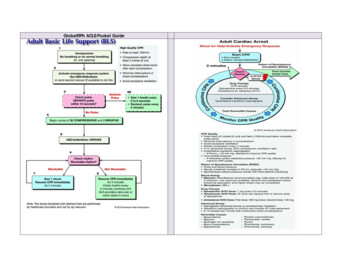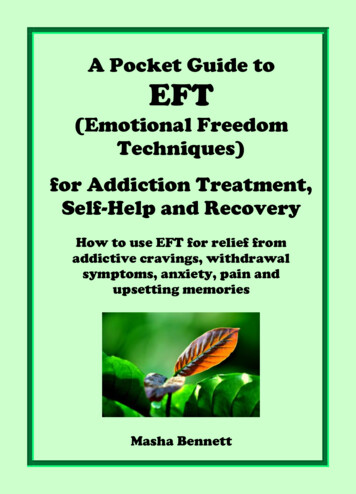
Transcription
A Pocket Guide toEFT(Emotional FreedomTechniques)for Addiction Treatment,Self-Help and RecoveryHow to use EFT for relief fromaddictive cravings, withdrawalsymptoms, anxiety, pain andupsetting memoriesMasha Bennett
“Addictive behaviour is the mindbody’s normal and natural responseto the pathology of sobriety”(Gregory Bateson)What is EFT?The Emotional Freedom Techniques are a group of brieftherapeutic interventions and self-help tools,sometimes known as “acupuncture without needles” or“tapping therapy”. EFT brings together the principles oftraditional Chinese medicine, neuroscience andcognitive-behavioural therapy by combining stimulationof a series of acupressure points with cognitiverestructuring (specially worded affirmations), typicallyleading to shifts in thought patterns and relief fromboth physical tension and excess negative emotions.Table 1. Uses of EFT in addiction recovery Reducing / eliminating addictive cravings Alleviating withdrawal symptoms Managing anxiety, fear, grief, anger Relieving physical pain and tension Modifying unhelpful beliefs Healing past trauma Enhancing sense of control and self-efficacy Reducing risk of relapseDay-to-day emotional & stress management
How does EFT work?There are several explanations of how EFT works. Thecreator of the technique and many practitionersattribute its effect to balancing the energy in meridians,as in acupuncture, in relation to a specific problem.Some neurological explanations for its efficacy includebalancing the activity of parasympathetic andsympathetic branches of our nervous system, andfacilitating “adaptive information processing”. The areasof skin associated with acupressure points contain ahigh concentration of mechanoreceptors, and brainscans of people whose acu-points are stimulated showthe limbic (emotional) part of the brain being impactedby EFT - including the amygdala, which plays animportant part in addictive and compulsive behaviours.“EFT brings immediateresults. It makes mefeel in control andindependent, increasesfaith and confidence inmyself and myabilities. It is a tool Ican use anywhere itis simple, but sopowerful.” (J. S.)Research is ongoing toevaluate the efficacy of EFT,but thousands of case studieshave already been published.Numerousprofessionals,clients and members of thegeneral public are reportingprofound and long-lastingbenefits of EFT as atherapeutic intervention anda self-help tool.
EFT Procedure for Self-helpIn this pocket guide I will describe a modified version ofthe original “EFT Basic Recipe”. One “round” or cycle ofEFT would usually take just a minute or two, and can berepeated a number of times until relief from a craving,tension, pain or negative emotion is achieved.Step 1 - Awareness. Become aware of the problemyou would like to work on. Notice any unpleasant bodilysensations, any tension, anxiety, or negative thoughts.Describe what is bothering you concisely but specifically– for example, “alcohol craving”, “thudding headache”,“worry about tomorrow’s interview”, “anger at JoeBloggs for not ringing me”. Rate the problem on thescale of 1 to 10, where 1 is the mildest, and 10 is thehighest intensity of the problem.
Step 2 - Balancing (or “The Set-Up”). For thisstep, you will need to locate one of the following twopoints (it doesn’t matter which, it depends on personalpreference). Either, find the Karate Chop point (Fig.1) –on the fleshy side of your palm (left or right) below thelittle finger – this is the area you would use for choppingbricks in half if you were doing Karate! Tap this gentlybut quite fast with the four fingers of your other hand(it is usually easiest to tap with your dominant hand,right or left, it doesn’t matter).Alternatively, locate the Sore Spot (labelled SS in Fig.2)– by prodding your chest in the area where you mightpin a badge (either side, left or right). The Sore Spot isusually about 2in/5cm in diameter and feels sore ortender when pressed with your fingers. This is the onlypoint in EFT that is massaged in a circular fashion, ratherthan tapped – the Sore Spot is not an acupressure pointbut is a so-called “neurolymphatic point”.Fig.1. EFT Karate Chop Point - KC.
CBSSUAFig.2. EFT body points, including: SS – Sore Spot, CB –Collar Bone point, UA – Under Arm point.Now, during the Balancing step we introduce thepsychological component of EFT by using a “Set-upPhrase” or affirmation that aims to both acknowledgethe problem and, at the same time, “balance” it withself-acceptance. This helps to reduce the impact of selfsabotage, or the so-called “psychological reversal”which can happen when we are critical and harshtowards ourselves (which is so common with addictionsand other chronic problems) and think thoughts such as“I am a failure”, “It won’t work for me”, “I don’t deserveto get better”, “Nothing can help me”, and so on.The basic structure of the EFT Set-up Phrase is:
“Even though [the problem], I accept myself.” E.g. “Even though I really need this drink [cigarette, hit,chocolate etc], I accept myself.”“Even though I have this horrible nagging headache, Iaccept myself.”“Even though I am anxious about tomorrow’s interview,I accept myself.”Gary Craig’s original Set-up Phrase is: “Even though[describe the problem], I deeply and completely acceptmyself.” Experience shows that this affirmation usuallyworks well as part of the EFT procedure, even if youdon’t quite believe it. If you are uncomfortable with thestatement of self-acceptance, you may want to try someof the alternatives listed in Table 2 overleaf.For Balancing, repeat the Set-up Phrase three times,whilst continuously tapping on the Karate Chop point,OR rubbing the Sore Spot (choose just one of the two).Step 3 - Clearing, or “The Sequence”. TheClearing part of the EFT procedure aims to “clear” theenergetic and/or neurological imbalances that arecontributing to the issue, by tapping on the sequenceof acu-points whilst you mentally focus on the problem.
Fig. 3. EFT FacePoints, including,from top tobottom:EB – EyebrowSE - Side of EyeUE - Under EyeUN - Under NoseCH – ChinUsing two fingers of one hand (left or right), tap gentlyon each of the following points (approximately 7-8 tapsis enough, but you don’t need to count):EB – Beginning of eyebrow (Fig.3)SE – Side of the eye on the edge of the bone (Fig.3)UE – Under the eye on the edge of the bone (Fig.3)UN – Under the nose (Fig. 3)CH – The dip in your chin - not the end of chin (Fig.3)CB – Edge of your collarbone (the precise acu-point is inthe dip just under the collarbone) (Fig. 2)UA – Under arm (on the seam of your top, about 4in /10cm below the armpit; for women – where you canfeel your bra, for men – level with nipple) (Fig.2)
Table 2. Some alternative Set-up Phrases“Even though [describe problem here].I accept a part of myself.” I am OK / all right.” deep, deep, deep down *insert as many “deeps” as youfeel is necessary], I am an OK person.” I am doing my best.” I am cool.” I accept the possibility that one day I may acceptmyself.” I give myself permission to be *hopeful, kind to myself,curious etc].” I’d like to bring healing to this.” I’d like to get better.” I am open to a possibility of change [healing, health,acceptance, peace etc .” I accept that this is where I am right now.” I accept that I am only human.”“In a very short time,EFT relieved me of thedistress, anxiety, fearand hate caused by mymarriage breakdown”(E. L.)
At each point say a Reminder Phrase to yourself: “This *name the problem here ”, e.g. “This nagging ache in myforehead”, “This anger with Joe Bloggs for not ringingme”, “This anxiety about the interview tomorrow”. Thepurpose of the Reminder Phrase is to focus you on thespecific distressing issue, which is important for EFT tobe effective.Following the Under Arm point, move to tapping onyour hand (left or right, it doesn’t matter), using twofingers of your other hand (Fig. 4):TH – Thumb – outer edge of the nailIF – Index Finger – edge of the nail nearest to thumbMF – Index Finger – edge of the nail nearest to thumbFig 4. EFT FingerPoints:TH – ThumbIF – Index FingerMF – Middle FingerRF – Ring FingerLF – Little Finger
RF – Ring Finger – edge of the nail nearest to little finger(you may see this finger being missed out in someversions of the procedure)LF – Little Finger – edge of the nail nearest to thumbAnd finishing with tapping on KC – Karate Chop (Fig. 1)You can use an abbreviated version of the procedure bymissing out all the points on the hand and, instead,after the Under Arm point, lightly tapping with all yourfingers on top of your head. There are a number ofdifferent acu-points located there, so you don’t need toaim at any particular spot. (Important note: It is bestnot to stimulate the points on the head for people whohave high blood pressure.)
“EFT brings me aprofound sense ofpeace & connectedness with somethinggreater than myself- call it what youlike: God, spirit,universalconsciousness, ‘theforce’ ” (N. R.)Step 4 - Evaluation. Focus on the problem or issueagain, and notice how you feel. Check the rating on thescale of 1 to 10 – is the intensity the same, or has itsubsided? Is there anything different about the feeling,sensation or the thought? Often people have insights ornew awareness coming to their mind when they tap.Persistence is importantSome simple problems may be relieved completely aftera couple of rounds of tapping, but the more complexones require perseverance. Repeat the procedure asmany times as necessary, every time changing thewords of the Set-up Phrase and the Reminder Phrase to
describe what is happening now, acknowledging anychanges (even small ones) that you noticed, e.g.:“Even though I still can’t stop thinking of alcohol, thiscraving is maybe a little less, and I accept myself.”“Even though I still have some of this annoyingheadache, I am cool.”“Even though I feel more sad than angry now about JoeBloggs not ringing me, I am an OK person.”“Even though I am still a little anxious about tomorrow’sinterview, I accept this is where I am now.”And for the Reminder Phrase in Step 3:“Remaining craving ”“Remaining headache ”“Sad about Joe Bloggs not getting in touch.”“Remaining anxiety about tomorrow’s interview.”Dealing with challengesIf EFT does not appear to be working , try one or all ofthe following: (1) make sure the wording of your Set-upand Reminder Phrase is specific; (2) drink some water;(3) keep both feet flat on the floor while tapping; (4) putsome emphasis into your words, even shout if you like!Possible side-effects of EFT could include: sleepiness,temporary increase in emotion (if this occurs, continuetapping until it subsides to comfortable levels), physicalsensations shifting to another part of the body (again,continue tapping), feeling of thirst (drink water).
What to expectSome of the typical results that many people in recoveryare able to achieve with the use of EFT include: Intensity of craving or urge decreases Perceived smell of addictive substance changes(usually to unpleasant or neutral) Physical tension reduces Anxiety drops to a manageable level Pains, aches, nausea and other withdrawalsymptoms are alleviated Anger, sadness, grief ease gradually Quality of sleep improvesMany people report warmth and lightness in their body,gentle tingling, a sense of relaxation and peace, duringor immediately after using EFT.
“I have hadvery positiveexperiences withpain relief andhelping to sleep.”(H. H.)“EFT has given me a toolbox oftechniques that I can effectivelyuse for myself, family andfriends.” (A.W.)EFT Shortcut for Cravings and AnxietyIf you find yourself in a difficult situation, and a triggersets off a craving, you could try an EFT shortcut that canhelp quickly, without having to go through the wholeprocedure. Tap on these points on both sides of bodysimultaneously, whilst focusing on the body sensations,emotions and thoughts associated with the craving:Under Eye, Collar Bone, Under Arm, Collar BoneRepeat several times without pausing, until the intensitysubsides. Revert to the full EFT protocol if needed.Picture credits: Yuri Kurilov www.prostoyput.ru; Namelesswww.uncommonforum.com; Evgeni Dinev www.FreeDigitalPhotos.net;Graur Razvan Ionut www.FreeDigitalPhotos.net.
About the author of this guideMasha Bennett is a former Drug TreatmentManager and Drug Worker, who combinesher own psychotherapy and training practicewith work as a therapist in the NHS. Mashateaches EFT around the world (in the UK,Norway, Israel, Russia, Lithuania, Latvia, Kazakhstan andother countries) to health and care professionals, addictionpractitioners, mental health workers, teachers, counsellors,psychotherapists, prison staff and prisoners, carers andpeople in recovery. To find out more about EFT and how itcan help, visit Masha’s websites www.eft4addictions.co.ukand www.practicalhappiness.co.uk.“In my experience EFTis a gateway topersonal power andwholeness.” (R. R.)“Being able to do itby myself has allowedme to work onpersonal materialthat I could not say infront of anyone else.”(M.H.)
EFT would usually take just a minute or two, and can be repeated a number of times until relief from a craving, tension, pain or negative emotion is achieved. Step 1 - Awareness. Become aware of the problem you would like to work on. Notice any unpleasant bodily sensations, any tension, anxiety, or negative thoughts. Describe what is bothering you concisely but specifically – for example .

